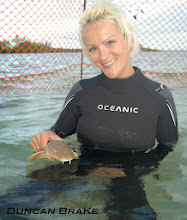Our Dutch Caribbean Sharks4Kids Shark Education Tour kicked off on the
beautiful island of Sint Eustatius (Statia). Statia is rich in history and
packs a lot of punch for a little island! We hit the ground running, presenting
at the Caribbean Netherlands Science Institute Science Café. This is a monthly
event, but they added a bonus presentation to coordinate with our visit. Duncan
and I talked about the role of media and science in shark conservation. We had
a much larger crowd than expected and thoroughly enjoyed the conversations that
followed our presentation. It was clear from the minute we arrived; Statia has
some shark lovers! Our hosts for this portion of our shark tour were Marine
Park Manager Jessica Berkel and STENAPA (Sint Eustatius National Parks)
education director Clair Blair. Both women went above and beyond to make the
most of our short trip.
Our next day started early, as we had a busy schedule of
school visits organized by Clair, who escorted us to each and every place.
Although she heard our talks a dozen times, not once did she seem uninterested.
We really cannot thank her enough for her support! It is easy to see she
absolutely loves working with the children and her enthusiasm is contagious,
easily seen in the energy and excitement emanating students she works with.
The first morning we visited both Golden Rock Roman Catholic School and
Bethel Methodist School speaking to students in grades
1-6. We were impressed with their knowledge of sharks and excitement to ask us
questions. We discussed what makes a shark a shark, why they are important, how
we learn about sharks, shark sanctuaries and how the students can continue to
do even more to save these amazing animals.
 |
| Naming Shark Species at the Golden Rock School |
We
are originally scheduled to visit the island during their “Shark Week,” in August,
but hurricane Erika changed our plans. During the week the students
participated in LOTS of sharky activities and events. A coloring contest was
hosted and we were lucky enough to be there with Claire as she awarded the
prizes. There were some really great coloring sheets and artwork created by the
kids and we were excited to see Shark Stanley make an appearance!
In
the afternoon we visited the incredible Mega D Youth Foundation, an afterschool
program developed by reggae star Mega D. This is an incredible program, which
incorporates older students mentoring the younger kids. The students were eager
to ask questions and we really enjoyed seeing all the opportunities this
program is offering the kids of the island.
Our
luggage, containing our stuffed shark and Duncan’s shark suit arrived the next
day, so the first schools missed out on Mr. Shark, but day 2 he was a crowd
favorite. It makes my heart happy to see kids so excited about hi-fiving and
saying hi to the shark! Not an action figure or celebrity, but he was
definitely a super hero for the day. We had a busy morning visiting the 2 other
primary schools on the island, Lynch Plantation Seventh Day Adventist School and Governor de Graaf School. The
SDA school provided us with the most beautiful classroom we’ve ever been in;
open air and a breathtaking view. Once again we were amazed by the excitement
and the great questions! These students are doing their part to save sharks.
Our
final presentations were at the Governor de Graaf School and they really ended
our trip on a high note. We definitely have some future marine biologists in
the group and some shark divers! We loved the questions, the artwork, the hugs
and the positive shark vibes. This was a great way to finish our brief, but
amazing visit.
As a
person who lives on a rock (island), the culture and community on other rocks I
visit always fascinate me and Statia definitely intrigued me. I cannot wait to
return to this beautiful Caribbean gem. Claire gave us a bit of a hi-speed tour while we
ate sandwiches before heading to the airport to catch our flight back to Sint
Maarten.
 |
| Duncan and I at Fort Oranje |
Special
thanks to Claire and Jessica for all their work in coordinating the visit and
to the wonderful students, teachers and people of Sint Eustatius! We will be back!
Shark Week 2016!








































